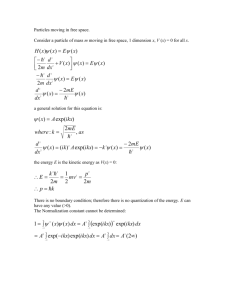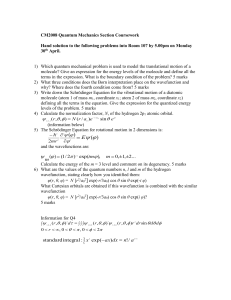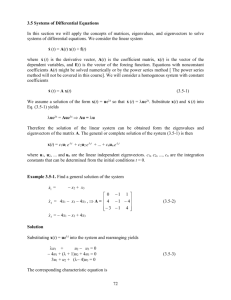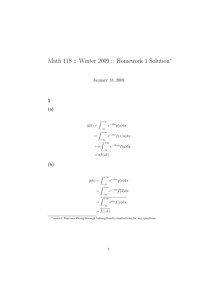Physics 443, Solutions to PS 1
advertisement
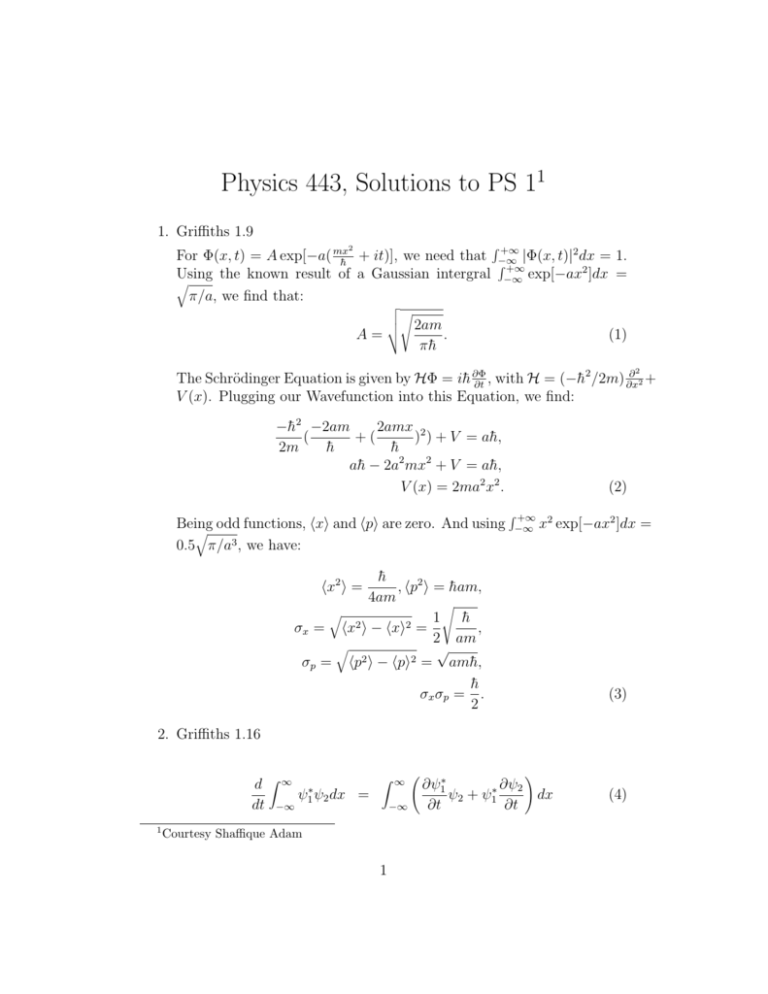
Physics 443, Solutions to PS 11 1. Griffiths 1.9 2 +∞ For Φ(x, t) = A exp[−a( mx + it)], we need that R−∞ |Φ(x, t)|2 dx = 1. h̄ +∞ Using the known result of a Gaussian intergral −∞ exp[−ax2 ]dx = q π/a, we find that: R A= vs u u 2am t πh̄ . (1) 2 ∂ The Schrödinger Equation is given by HΦ = ih̄ ∂Φ , with H = (−h̄2 /2m) ∂x 2+ ∂t V (x). Plugging our Wavefunction into this Equation, we find: 2amx 2 −h̄2 −2am ( +( ) ) + V = ah̄, 2m h̄ h̄ ah̄ − 2a2 mx2 + V = ah̄, V (x) = 2ma2 x2 . Being odd functions, hxi and hpi are zero. And using q 0.5 π/a3 , we have: (2) R +∞ 2 x exp[−ax2 ]dx −∞ h̄ , hp2 i = h̄am, 4am s q 1 h̄ σx = hx2 i − hxi2 = , 2 am q √ σp = hp2 i − hpi2 = amh̄, h̄ σx σp = . 2 hx2 i = (3) 2. Griffiths 1.16 ! Z ∞ d Z∞ ∗ ∂ψ1∗ ∂ψ 2 ψ ψ2 dx = ψ2 + ψ1∗ dx dt −∞ 1 ∂t ∂t −∞ 1 Courtesy Shaffique Adam 1 (4) = We use Schrodinger’s equation and its complex conjugate to replace the time derivatives with space derivatives and the potential V (x). V (x) is assumed real and independent of time. Z ∞ " i d Z∞ ∗ ψ1 ψ2 dx = dt −∞ −∞ h̄ i = h̄ −h̄2 ∂ 2 ψ1∗ i ∗ −h̄2 ∂ 2 ψ2 ∗ ψ + V ψ ψ − + V ψ2 2 1 2m ∂x2 h̄ 1 2m ∂x2 ! ! ! 2 −h̄2 Z ∞ ∂ 2 ψ1∗ ∗ ∂ ψ2 dx ψ2 − ψ1 2m ∂x2 ∂x2 −∞ Integrate by parts and use the fact that normalizable wave functions are zero at infinity to drop the total derivative. Then ! ! d Z∞ ∗ −ih̄ Z ∞ ∂ψ1∗ ∂ψ2 ∂ψ1∗ ∂ψ2 ψ ψ2 dx = − dx dt −∞ 1 2m ∂x ∂x ∂x ∂x −∞ = 0 3. Griffiths 2.5 (a) We have that q Ψ(x, 0) = A[ψ1 (x)+ψ2 (x)]. We know that the states ψn (x) = L2 sin kn x, with kn = nπ/L are normalized, orthogonal and real. Then Z L Ψ∗ (x, 0)Ψ(x, 0)dx = |A|2 0 Z L 0 |ψ1 |2 + |ψ2 |2 + 2ψ1 ψ2 dx 2 = |A| (2) = 1 1 → A= √ 2 (b) 1 Ψ(x, t) = √ ψ1 (x)e−iω1 t + ψ2 (x)e−iω2 t 2 where ωn = 2 h̄kn . 2m (5) Then i 1h |ψ1 (x)|2 + |ψ2 (x)|2 + 2ψ1 (x)ψ2 (x) cos(∆ωt) 2 i 1h 2 = sin (k1 x) + sin2 (k2 x) + 2 sin(k1 x) sin(k2 x) cos ∆ωt L |Ψ(x, t)|2 = where ∆ω = ω1 − ω2 2 !# dx (c) hxi = Z L x|Ψ(x, t)|2 dx 0 i 1 Z Lh x sin2 (k1 x) + x sin2 (k2 x) + 2x sin(k1 x) sin(k2 x) cos ∆ωt dx "L 0 ! # L L 2 1 1 = + + − + cos ∆ωt 2 2 L (π/L)2 (3π/L)2 8 = L 1 − 2 cos ∆ωt 9π = We got the first two terms in the integration by inspection since sin2 kx is symmetric about the midpoint of the well. We find the integral of the third term in a table. It is appended at the end of this solution set. The amplitude of the oscillation is 8L 9π 2 (d) d 8L hxi = 2 ∆ω sin ∆ωt dt 9π (e) An energy measurement would yield either E1 or E2 . The probability of measuring E1 is equivalent to the probablity that Ψ is in the state ψ1 , namely hpi = m P1 = | Z ψ1 (x)Ψ(x, t)dx|2 = 1 hHi = (E1 + E2 ) 2 4. Griffiths 2.21 (a) To normalize the wave function set Z ∞ |Ψ(x, 0)|2 dx = 1 −∞ where Ψ(x, 0) = Ae−a|x| 3 1 2 Then Z ∞ |Ψ(x, 0)|2 dx = 1, −∞ = |A|2 Z ∞ e−2ax + Z 0 e2ax dx −∞ 0 1 = |A|2 2 =1 √ 2a → A= a (b) The momentum distribution 1 Z∞ Ψ(x, 0)e−ikx dx φ(k) = √ −∞ 2π r Z ∞ a −a|x| −ikx φ(k) = e e dx 2π −∞ r Z ∞ Z 0 a eax−ikx dx e−ax−ikx + = 2π 0 −∞ ! r −ax−ikx ax−ikx a e e ∞ 0 = | + | 2π −a − ik 0 a − ik −∞ r a 1 1 = + 2π a + ik a − ik r a 2a = 2π a2 + k 2 (c) √ 1 Z ∞ 2 a3 i(kx−ωk t) 1 Z∞ i(kx−ωk t) φ(k)e dk = Ψ(x, t) = e dk 2π −∞ 2π −∞ a2 + k 2 and ωk = h̄k2 . 2m (d) In the limit where a ⇒ ∞, 1 Z ∞ i(kx−ωk t) Ψ(x, t) → √ e dk π a −∞ which looks like √2a δ(x) at t = 0 and will spread out in time due to the k dependence of ω. In the limit a → 0, 1 Z ∞ 1 i(kx−ωk t) Ψ(x, t) = √ e dk a3 π −∞ k 2 4 Small k, (long wavelenghts) will dominate the distribution at t = 0. 5. Griffiths 2.22 We have Ψ(x, 0) = vs u u 2a t π exp(−ax2 ). The way to solve this problem is take the Fourier transform φ(k), since we know how to time evolve φ(k) for a free particle. In particular, we have the following relations s ih̄k 2 t 1 Z +∞ dk φ(k) exp(−ikx − ) 2π −∞ 2m s 1 Z +∞ 0 dx Ψ(x0 , 0) exp(−ikx0 ). 2π −∞ Ψ(x, t) = φ(k) = Putting these two equations together, one can solve for Ψ(x, t) as 1 1 Z Z 2a 4 −ih̄k 2 t Ψ(x, t) = ) dx0 dk, exp(−ax0 2 ) exp(−ikx0 ) exp(ikx) exp( 2π π 2m 1 1 2a 4 Z Z = dydk exp(−ay 2 − iky + ikx − ih̄k 2 t/2m). 2π π This looks like a mess, but it is really just two integrals of the form given in the hint. Performing the integral over dy first, and then dk, we have 1 Ψ(x, t) = 2π 1 = 2π = 2a π 2a π 1 Z 4 2a π 1 s 1 4 4 r dk π k2 ih̄k 2 t exp − + ikx − , a 4a 2m ! 1 1 −x2 q exp , 4a 1/4a + ih̄t/2m 4(1/4a + ih̄t/2m) ! −ax2 q exp 1 + 2ih̄at/m 1 + 2ih̄at/m 1 5 ! 2 Using the definition of ω = answer as q a/[1 + (2h̄at/m)2 ], we can rewrite our s |Ψ(x, t)|2 = 2 −2ω2 x2 ωe . π For large t, we have that ω is inversely proportional to time, so the wavefunction is of the same form but with its rms spread proportional to t. We can also notice that when written in this form, that hxi, hpi = 0. For hx2 i, we integrate directly and find 1/4ω 2 . hp2 i involves integration by parts as follows 2 Z Ψ∗ ∇2 Ψ, 2 Z ∇Ψ∗ ∇Ψ, 2 hp i = −h̄ = +h̄ s 2 Z ω π s Z 1 3 4aω x2 exp(−2ω 2 x2 ), π 2 = h̄ 2 = h̄ −2ax 1 − 2ih̄at/m ! ! −2ax exp(−2ω 2 x2 ), 1 + 2ih̄at/m = h̄2 a. (6) √ √ We see that σx σp = h̄ a/(2ω), which when t → 0, ω → a, and σx σp = h̄/2. 6. Current Vector Find the current density carried by a plane wave Aeikx in one dimension, showing that it is in fact what one would expect from the formula ρv, and verify that it satisfies the equation of continuity. [For ψ = A exp(ikx), We know that the current density is ih̄ ∂ψ ∗ ∂ψ j = ψ − ψ∗ , 2m ∂x ∂x ih̄ = (−ikA2 − ikA2 ). 2m ! (7) Therefore, j = (h̄k/m)(A2 ) = (v)(ρ). The continuity equation ∂t ρ = −∇.j is trivially satisfied.] 6 7. Commutators Prove the following: [Â, B̂] = −[B̂, Â] [Â + B̂, Ĉ] = [Â, Ĉ] + [B̂, Ĉ] [a, Â] = 0 [aÂ, B̂] = a[Â, B̂] [ÂB̂, Ĉ] = Â[B̂, Ĉ] + [Â, Ĉ]B̂ where a is a constant number. [Using the definition that [A, B] = AB − BA, it is straight forward to show these relations. We just do one of them here. [AB, C] = ABC − CAB = ABC + (−ACB + ACB) + (−ACB + ACB) − CAB = A[B, C] + (ACB − ACB) + [A, C]B = A[B, C] + [A, C]B 2 (8) 8. Sum Rule (a) Consider the commutator [H, x] p2 + V (x), x] 2m 1 2 [p , x] = 2m 1 = (p[p, x] + [p, x]p) (where we have used the result of problem 7.) 2m −ih̄ = p m [H, x] = [ Then hψn | [H, x] | ψn0 i = hψn | [Hx − xH] | ψn0 i ih̄ − hψn | p | ψn0 i = hψn | (En x − xEn0 ) | ψn0 i m = (En − En0 ) hψn | x | ψn0 i m → hψn | p | ψn0 i = i (En − En0 ) hψn | x | ψn0 i h̄ 7 (b) D ψn | p2 | ψn0 E m2 h̄2 m2 = − 2 h̄ m2 = − 2 h̄ = − = − D E D E ψn | [H, x]2 | ψn0 ψn | [H, x]2 | ψn0 X hψn | [H, x] | ψn0 i hψn0 | [H, x] | ψn i (9) (10) n0 m2 X (En − En0 ) hψn | x | ψn0 i (En0 − En ) hψn0 | x | ψn i h̄2 n0 = m2 X (En − En0 )2 hψn | x | ψn0 i hψn0 | x | ψn i h̄2 n0 = m2 X (En − En0 )2 | hψn | x | ψn0 i |2 h̄2 n0 In going from Equation 9 to 10 we use the fact the | ψn0 i is a complete set. Integrals Z 1 x sin(ax) sin(bx)dx = 2 cos(a − b)x cos(a − b)x x sin(a − b)x x sin(a + b)x − + − (a − b)2 (a + b)2 a−b a+b 8 !


